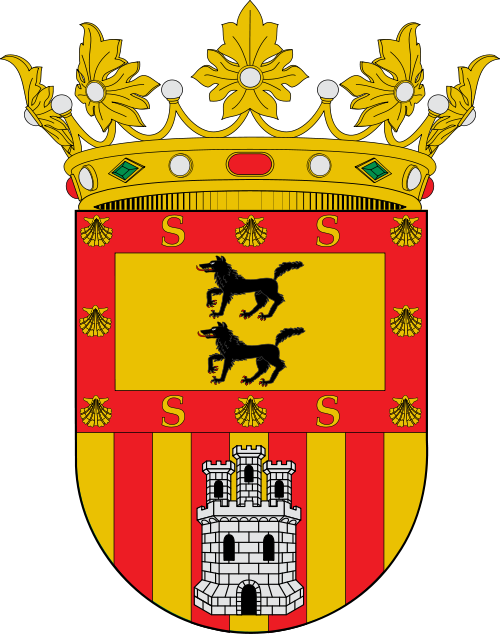There are many archaeological finds that demonstrate a human presence in Planes de la Baronía since Prehistory. In the first place, the Cave of En Pardo stands out, with remains that show a human presence between the Upper Paleolithic and full Iberianism. Those of the Cueva del Barranco de la Encantada are from the Epipaleolithic, while those of the Peña Roja de Catamarruch can already be located in the Neolithic. The next period, the Eneolithic, belongs to the town of Tros de la Bassa and the remains of the Alturó del Mas del Moro and the Cuevas de la Vila. Samples of schematic rock art were found in the Gleda shelter and in the Garrofers ravine, and in the Levantine in the Peña Blanca ravine and in the already mentioned Cuevas de la Vila. With the Bronze, settlements appear in the area of the hermitage of Cristo and in that of the castle, declared BIC, and other materials in the Peña de Margarida.
Finally, Iberianism is reflected in the aforementioned town of the hermitage of Cristo, in Los Llombos and in the town located in the Sierra del Xarpolar. Undoubtedly, the proximity of this municipality to the places where the rebellions of the Saracen Al-Azraq (1208-1276), valid from Alcalà de la Jovada, took place, was decisive in the development of its history. It was in the year 1245 when the Moors of the valleys of Planes, Gallinera, Alcalà, Cocentaina and Alcoy, seeing themselves surrounded by the hosts of the King of Aragon and without the possibility of defense, surrendered to the Conqueror by means of a vassalage pact, stipulated with the Saracens. notable people from that area, including Al-Azraq. In the so-called pacte del pouet, the Moorish sheikh reserved, as a family inheritance, the castles of Alcalà and Perpuxent (l’Orxa), while all the places and castles of La Marina and the Gallinera Valley passed to the domain of Jaime I .
It was in 1259, when the first rebellion of Al-Azraq ended with victory, when Don Jaime decided to take over direct control of the Castle of Planes, as it was the closest to the Saracen’s lair in the Valley of Alcalà. The Christians who, progressively, will settle in Planes, in an attempt to respect the tolerant character of the king, will try to maintain peaceful coexistence with the Moors who decided to remain in these lands after the conquest. Having a good deal with the ancient settlers also ensured that the fields continued to be worked and provided their wealth. Even so, this coexistence will have its setbacks, especially due to the successive rebellions led by Al-Azraq, which will end on April 23, 1276 in the Barranco de la Batalla, in the vicinity of Alcoy, where he will be killed.
The defeat of the Muslim uprising of 1276-77 marks the beginning of a settlement of settlers who will displace the Muslim population from the Planes valley. In June 1278 Teresa Gil de Vidaure proceeds to establish in Planes a large group of Christian settlers who must form a town around the castle, according to one of the clauses of the letter puebla. The other towns of the Baronía (Almudaina, Apta, Benialfaquí, Benicapsell, Burbaca, Catamarruc, Llombo and Margarida) will continue to be inhabited mainly by Moors until the definitive expulsion of the year 1609. Benicapsell, Llombo, Burbaca and Apta will not be repopulated again. Planes, inhabited by old Christians, was not so demographically affected by the expulsion.
Subsequently, the castle and the town of Planes will pass into the hands of various families of the nobility, not without problems or traumatic situations, especially in the period between the mid-fourteenth and mid-sixteenth centuries. It must be remembered that Planes belonged to the lordship of Cocentaina until the year 1425, when it became a Barony.
Among the lords and noble families who owned Plans of the Barony are the house of Jérica, who owned the town between 1276 and 1372, Pedro the Ceremonious and his son Juan I (1377-1426), Francesc Sarçola (1426-1434), the Centelles (1434-1466), the Catalàs (1466-1500), the Olzinas (1500-1554), Miguel Fenollar (1554), the royal administration of Felipe II (1554-1594), the Dukes of Maqueda (1594-1685) ), the Ponce de León (1685-1769) and the Marquisate of Cruïlles (1769-1837). It is not known exactly when the Marquis of Cruïlles sold their private possessions from the town of Planes, once they ceased to be lords.
Subsequently, the castle and the town of Planes will pass into the hands of various families of the nobility, not without problems or traumatic situations, especially in the period between the mid-fourteenth and mid-sixteenth centuries. It must be remembered that Planes belonged to the lordship of Cocentaina until the year 1425, when it became a Barony.
Among the lords and noble families who owned Plans of the Barony are the house of Jérica, who owned the town between 1276 and 1372, Pedro the Ceremonious and his son Juan I (1377-1426), Francesc Sarçola (1426-1434), the Centelles (1434-1466), the Catalàs (1466-1500), the Olzinas (1500-1554), Miguel Fenollar (1554), the royal administration of Felipe II (1554-1594), the Dukes of Maqueda (1594-1685) ), the Ponce de León (1685-1769) and the Marquisate of Cruïlles (1769-1837). It is not known exactly when the Marquis of Cruïlles sold their private possessions from the town of Planes, once they ceased to be lords.
In the corresponding volume (XIII) of the Madoz dictionary, published in 1849, it is still indicated that in the castle of Planes “the Marquis of Cruïlles, lord of the town, has his room, costumes and cellars”. The person referred to must be the fourth Marquis of Cruïlles, Vicente Salvador, who died in 1915.

